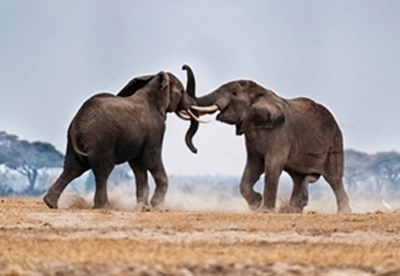 We have discussed many situations in which a large company faces a court challenge from a smaller company, from the government, or from a class of consumers or purchasers. Sometimes, those situations will be “David v. Goliath” cases, in which the large company, usually the defendant, must step carefully during the trial to avoid being cast as the “heavy” with all the legal and other resources. Jurors sometimes don’t look favorably on a big company.
We have discussed many situations in which a large company faces a court challenge from a smaller company, from the government, or from a class of consumers or purchasers. Sometimes, those situations will be “David v. Goliath” cases, in which the large company, usually the defendant, must step carefully during the trial to avoid being cast as the “heavy” with all the legal and other resources. Jurors sometimes don’t look favorably on a big company.
But what about cases that could be termed “Goliath v. Goliath,” in which both parties are large companies that jurors may be familiar with? It could be one airline against another, or one grocery chain against another, or one high-tech company against another. This type of case presents interesting challenges for the litigator.
The stakes in this type of case are often high; with two well-heeled parties, the litigation budgets are often relatively large; and a great many lawyers, usually from large law firms, are likely to be involved. In addition, there will usually be a good many consultants hired to help each side.
Even with or perhaps because of the many people involved, prepping the case will take longer, the trial is likely to take longer, and client expectations will be enormous.
In these challenging cases, we recommend the following:
- TEST THE CASE SEVERAL TIMES: Since the other side will be very well prepared, testing in the form of mock trials and focus groups is crucial.
- MEASURE AND TACKLE THE CLIENT'S REPUTATION HEAD ON: Your client’s brand may be one that people like and trust (such as Coca-Cola, Amazon.com, or Southwest Airlines), or a brand that has come under criticism (such as Goldman Sachs, Halliburton, or Comcast). It may also be one that has no clear consumer profile. In any case, in a case like this, it’s important for you to conduct surveys that indicate what consumer attitudes towards the client firm may be.
- TEST JUROR ATTITUDES TOWARD BIG COMPANIES, LIKE THESE, FIGHTING: Sometimes, jurors will show apathy or lack of interest in what they view as a sandbox battle between two giants. It’s important to test in advance and see whether this is the case.
- LET THE MOCK JURORS DRIVE THE LITIGATION GRAPHICS: The feedback from mock jurors should inform the graphics team about what is working best and what does not work.
- PLAN FOR USING TRIAL TECHNOLOGY: Both sides will use technology extensively. Reach an agreement with the judge well in advance about how it will be used.
There remain several unanswered questions that should be left up to the trial lawyer and the litigation consultant’s discretion. There is often some question about how much a jury should be told about a large company that may seem familiar. We take the position that more is generally better. People can see companies like Google, Amazon or Facebook as old behemoths and forget that they were founded in 1998, 1994, and 2004 respectively, as start-ups.
There are also some questions about how much the trial graphics should follow the client's corporate colors, if at all. In the recent Oracle v. Google patent dispute in the Northern District of California, which Google won decisively, both sides adopted the corporate colors for their clients in their litigation graphic presentations. In this case, Google's graphics closely match the brand and Oracle's are a close derivation. You can download Google's successful opening presentation created by the Five Corners Group here and Oracle's opening presentation created by Impact Trial Consulting here.
Other resources on the A2L Consulting site related to this article:






Leave a Comment